Deep Dive into Algorithms
Sharpen your logical thinking and coding skills with our comprehensive algorithm course, designed to help you build a strong foundation in computational problem-solving. Ideal for students, developers, and competitive programmers looking to learn algorithms the right way.
Level : Advance
Duration :90 hrs
Rating : 4.8/5
Language : Java
Activate this Course for :
₹ 6999
6999
Activate this Course for :
₹ 7999
7999
Enter Details
Deep Dive into Algorithms Course Overview
Understand core algorithmic concepts like time complexity, recursion, and divide-and-conquer
Learn essential sorting and searching techniques with step-by-step logic
Practice with advanced topics like dynamic programming, greedy algorithms, backtracking, and graph algorithms
Work on multiple algorithm programs using languages like Python, C++, or Java
Solve real-world problems and challenges designed to boost your coding speed and logic
Deep Dive into Algorithms Course Includes
Certification After completing the courses
We Provides 24/7 Dedicated Forum Support
Accessing to AI tools to enhance coding skills
Enjoy Lifetime access to course materials
Assessments to track your progress
Deep Dive into Algorithms Course Contents
-
1.1.What is an Algorithm?
-
1.2.Characteristics of a Good Algorithm
-
1.3.Algorithm Design Techniques Overview
-
1.4.Time and Space Complexity (Big O, Omega, Theta)
-
1.1.What is an Algorithm?
-
1.2.Characteristics of a Good Algorithm
-
1.3.Algorithm Design Techniques Overview
-
1.4.Time and Space Complexity (Big O, Omega, Theta)
-
2.1.Understanding Recursion with Examples
-
2.2.Backtracking Strategy and Use Cases
-
2.3.N-Queens, Sudoku Solver
-
2.4.Recursive Tree Visualization
-
2.1.Understanding Recursion with Examples
-
2.2.Backtracking Strategy and Use Cases
-
2.3.N-Queens, Sudoku Solver
-
2.4.Recursive Tree Visualization
-
3.1.Divide and Conquer Approach
-
3.2.Binary Search and Its Variants
-
3.3.Merge Sort, Quick Sort
-
3.4.Maximum Subarray Problem (Kadane’s Algorithm)
-
3.1.Divide and Conquer Approach
-
3.2.Binary Search and Its Variants
-
3.3.Merge Sort, Quick Sort
-
3.4.Maximum Subarray Problem (Kadane’s Algorithm)
-
4.1.Greedy Strategy Concept
-
4.2.Activity Selection Problem
-
4.3.Huffman Coding
-
4.4.Fractional Knapsack Problem
-
4.5.Comparison with Dynamic Programming
-
4.1.Greedy Strategy Concept
-
4.2.Activity Selection Problem
-
4.3.Huffman Coding
-
4.4.Fractional Knapsack Problem
-
4.5.Comparison with Dynamic Programming
-
5.1.Memoization and Tabulation
-
5.2.Fibonacci, Factorial, Subset Sum
-
5.3.0/1 Knapsack Problem
-
5.4.Coin Change Problem
-
5.1.Memoization and Tabulation
-
5.2.Fibonacci, Factorial, Subset Sum
-
5.3.0/1 Knapsack Problem
-
5.4.Coin Change Problem
-
6.1.Longest Common Subsequence (LCS)
-
6.2.Longest Increasing Subsequence (LIS)
-
6.3.Matrix Chain Multiplication
-
6.4.Rod Cutting Problem
-
6.1.Longest Common Subsequence (LCS)
-
6.2.Longest Increasing Subsequence (LIS)
-
6.3.Matrix Chain Multiplication
-
6.4.Rod Cutting Problem
-
7.1.Palindrome Partitioning
-
7.2.Edit Distance
-
7.3.Subset Partitioning
-
7.4.Boolean Parenthesization
-
7.1.Palindrome Partitioning
-
7.2.Edit Distance
-
7.3.Subset Partitioning
-
7.4.Boolean Parenthesization
-
8.1.Linear Search
-
8.2.Binary Search
-
8.3.Interpolation Search
-
8.4.Exponential Search
-
8.5.Ternary Search
-
8.1.Linear Search
-
8.2.Binary Search
-
8.3.Interpolation Search
-
8.4.Exponential Search
-
8.5.Ternary Search
-
9.1.Bubble Sort, Insertion Sort, Selection Sort
-
9.2.Stability and Time Complexity Analysis
-
9.1.Bubble Sort, Insertion Sort, Selection Sort
-
9.2.Stability and Time Complexity Analysis
-
10.1.Heap Sort
-
10.2.Counting Sort, Radix Sort, Bucket Sort
-
10.1.Heap Sort
-
10.2.Counting Sort, Radix Sort, Bucket Sort
-
11.1.Graph Representations
-
11.2.BFS, DFS (Recursive and Iterative)
-
11.3.Connected Components
-
11.4.Graph Traversal Applications
-
11.1.Graph Representations
-
11.2.BFS, DFS (Recursive and Iterative)
-
11.3.Connected Components
-
11.4.Graph Traversal Applications
-
12.1.Topological Sort
-
12.2.Cycle Detection (Directed and Undirected)
-
12.3.Bipartite Graph Check
-
12.1.Topological Sort
-
12.2.Cycle Detection (Directed and Undirected)
-
12.3.Bipartite Graph Check
-
13.1.Kruskal's Algorithm
-
13.2.Prim's Algorithm
-
13.3.Union-Find Data Structure
-
13.4.Disjoint Set Union (DSU)
-
13.1.Kruskal's Algorithm
-
13.2.Prim's Algorithm
-
13.3.Union-Find Data Structure
-
13.4.Disjoint Set Union (DSU)
-
14.1.Dijkstra's Algorithm
-
14.2.Bellman-Ford Algorithm
-
14.3.Floyd-Warshall Algorithm
-
14.4.0-1 BFS
-
14.1.Dijkstra's Algorithm
-
14.2.Bellman-Ford Algorithm
-
14.3.Floyd-Warshall Algorithm
-
14.4.0-1 BFS
-
15.1.Articulation Points and Bridges
-
15.2.Strongly Connected Components (Kosaraju’s Algorithm)
-
15.3.Tarjan’s Algorithm
-
15.1.Articulation Points and Bridges
-
15.2.Strongly Connected Components (Kosaraju’s Algorithm)
-
15.3.Tarjan’s Algorithm
-
16.1.Bitwise Operators
-
16.2.Bitmasking Problems
-
16.3.Subset Generation Using Bits
-
16.4.XOR Properties in Algorithms
-
16.1.Bitwise Operators
-
16.2.Bitmasking Problems
-
16.3.Subset Generation Using Bits
-
16.4.XOR Properties in Algorithms
-
17.1.Sieve of Eratosthenes
-
17.2.GCD and LCM (Euclidean Algorithm)
-
17.3.Modular Arithmetic and Exponentiation
-
17.4.Prime Factorization
-
17.1.Sieve of Eratosthenes
-
17.2.GCD and LCM (Euclidean Algorithm)
-
17.3.Modular Arithmetic and Exponentiation
-
17.4.Prime Factorization
-
18.1.Fixed-size and Variable-size Sliding Window
-
18.2.Two-pointer Applications in Arrays and Strings
-
18.3.Real-World Problems
-
18.1.Fixed-size and Variable-size Sliding Window
-
18.2.Two-pointer Applications in Arrays and Strings
-
18.3.Real-World Problems
-
19.1.Building a Trie
-
19.2.Word Search and Autocomplete
-
19.3.Prefix Matching and Counting
-
19.4.Advanced Trie Use Cases
-
19.1.Building a Trie
-
19.2.Word Search and Autocomplete
-
19.3.Prefix Matching and Counting
-
19.4.Advanced Trie Use Cases
-
20.1.Mixed Set of Algorithmic Problems
-
20.2.Real-life Applications
-
20.3.Timed Assessments and Optimization
-
20.4.Final Presentation
-
20.1.Mixed Set of Algorithmic Problems
-
20.2.Real-life Applications
-
20.3.Timed Assessments and Optimization
-
20.4.Final Presentation
Benefits
Our Dashboard offers 1500+ coding problems to sharpen skills and prepare for company-specific interviews. Track progress, build your profile, and boost job-readiness for successful technical interviews
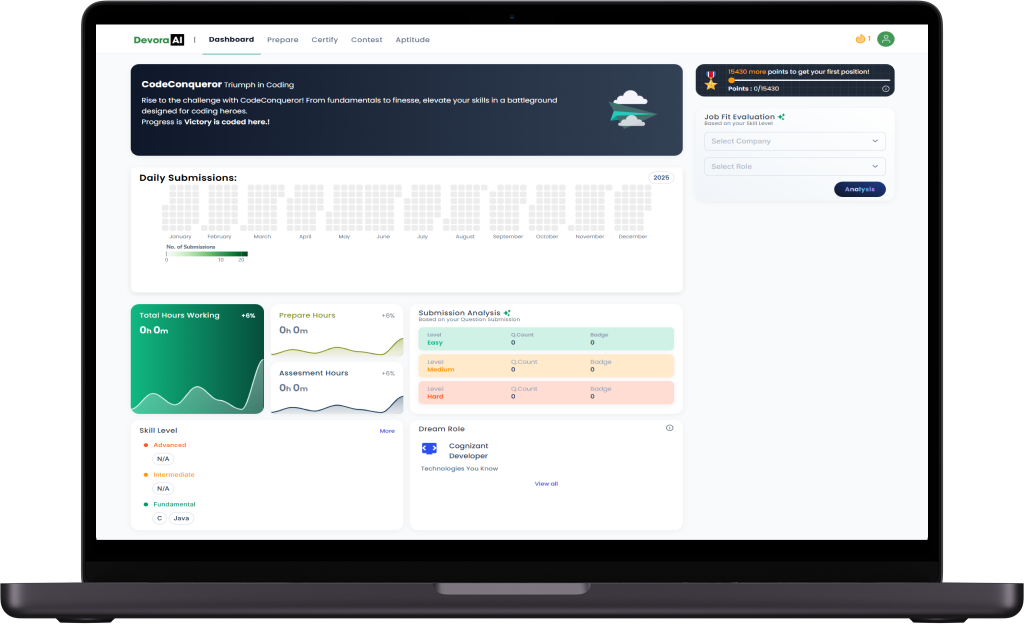
Our product provides real-time debugging assistance, allowing learners to efficiently identify and fix errors, enhancing their programming skills and understanding
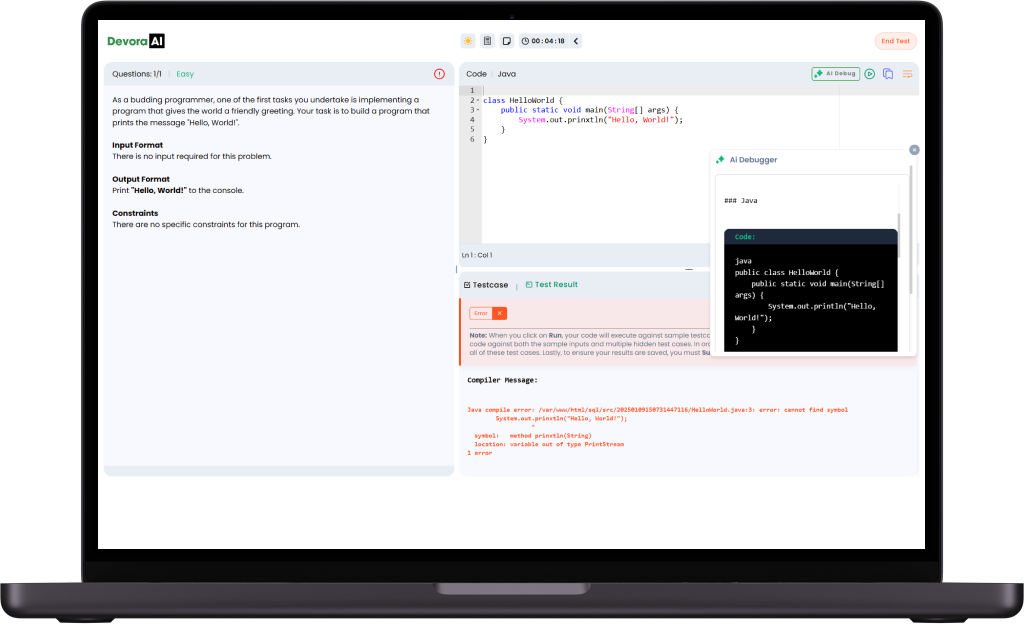
Our integrated IDE compiler offers a unified platform for writing, executing, and debugging code efficiently. With real-time execution and instant feedback, users can test and optimize their code seamlessly.
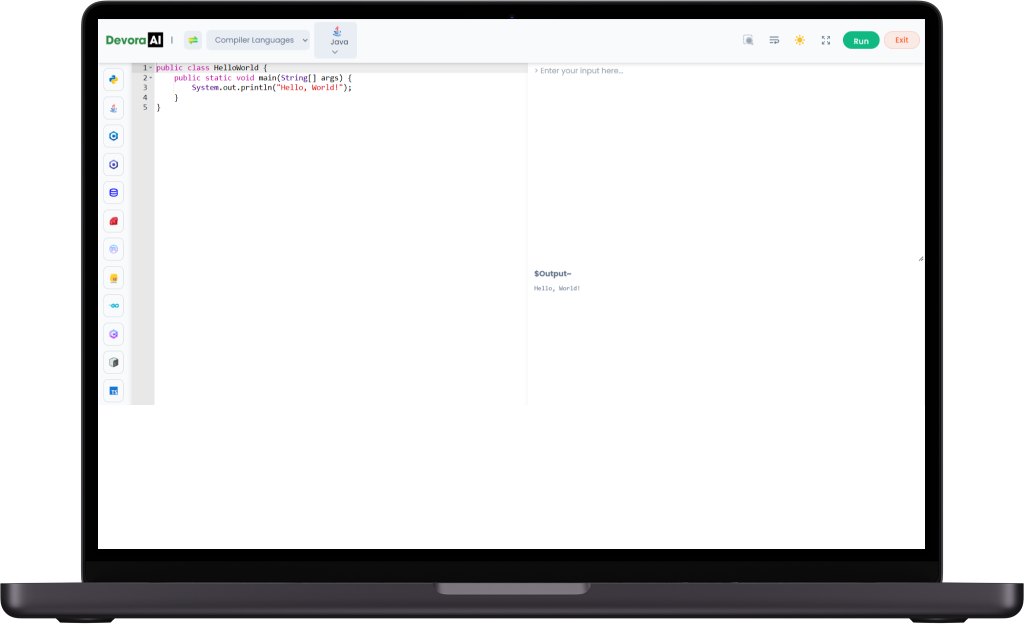
we organize coding contests within the platform, offering users the opportunity to compete against peers, test their problem-solving abilities, and enhance their skills through time-bound challenges and real-world scenarios
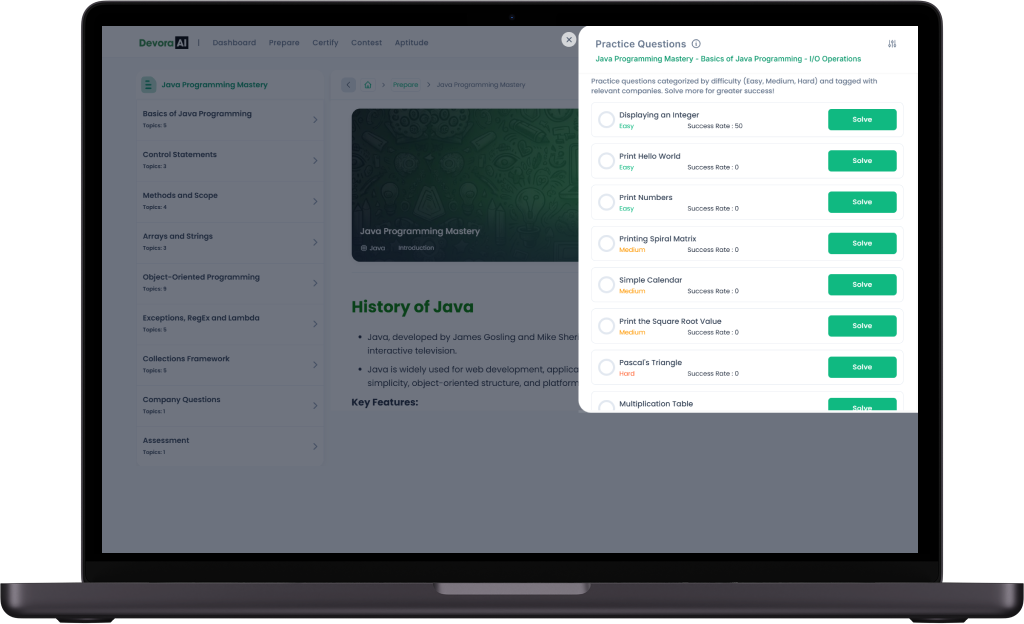
We maintain a personalized profile for each user, tracking their learning progress, performance in coding problems, and achievements,It also includes a record of completed contests, certifications earned, and coding skills developed etc

This is one For You
Hands on training
Looking to enhance your Coding skills
Innovation Ideas
lets you create innovative solutions, explore technologies
Newbie Programmer
Budding Programmer , Wants to learn some tricks and tips
Upskilling your skills
A professional wanting to Update their skills
Gain a Competitive Edge With Our Professional Certificates
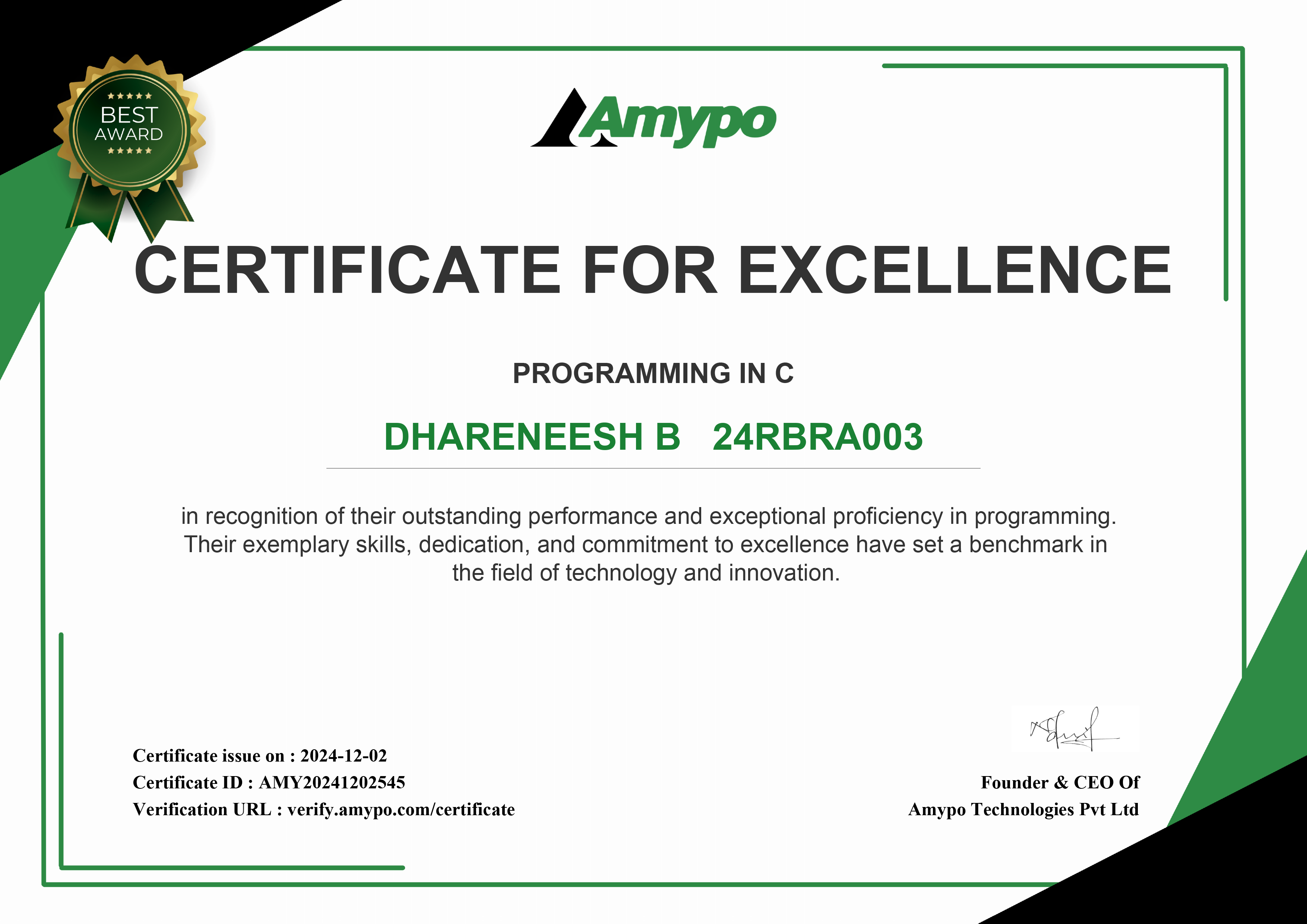
Master the latest programming languages and enhance your skill set with a recognized certificate.
unlock new career opportunities with a programming certificate


